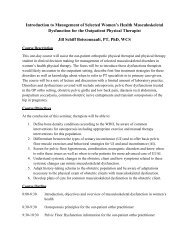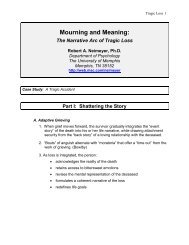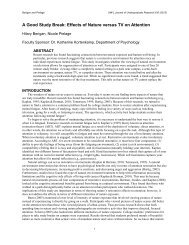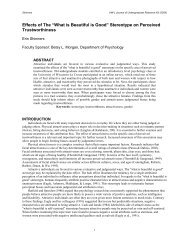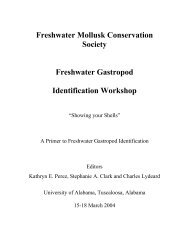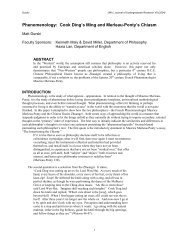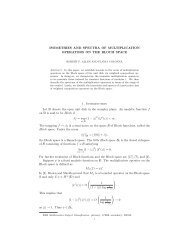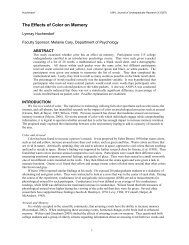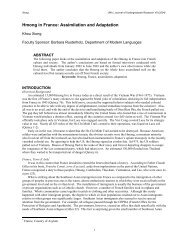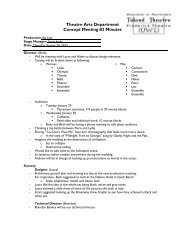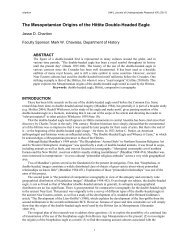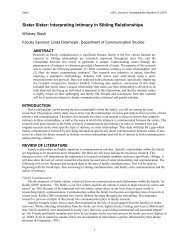species-specific. The family is currently distributed in East and Southeast Asia, the Philippines, the eastern half <strong>of</strong> North America, and Central America. The snails are found in moderately moist <strong>for</strong>ests in leaf litter and under dead wood and bark. TAXON AUTHOR G- RANK DISTRIBUTION AL, AR, DE, FL, GA, HI, IA, IL, IN, KY, LA, MA, MD, MI, MO, MS, NC, NJ, NY, OH, OK, PA, SC, TN, TX, VA, WI, WV; Canada: Strobilops aeneus Pilsbry, 1926 G5 NS IL, IN, KY, MA, ME, MI, MN, MO, NJ, NY, OH, PA, RI, TN, WI; Strobilops affinis Pilsbry, 1893 G4G5 Canada: MB, ON, QC Strobilops hubbardi A.D. Brown, 1861 G3G4 AL, FL, GA, TX AL, AR, CT, GA, IA, IL, IN, KS, KY, LA, MA, MD, ME, MI, MN, MO, MS, NC, NE, NH, NJ, NY, OH, OK, PA, SC, SD, TN, TX, VA, Strobilops labyrinthicus (Say, 1817) G5 VT, WI, WV; Canada: NB, NS, ON, QC AL, AR, DE, FL, GA, KS, LA, MD, MS, NC, NJ, OK, PA, SC, TN, Strobilops texasianus Pilsbry and Ferriss, 1906 G5 TX, VA Succineidae John B. Burch, <strong>University</strong> <strong>of</strong> Michigan The Succineidae are a land snail family nearly worldwide in distribution, whose shells are characteristically thin and amber-colored, the latter aspect the source <strong>of</strong> their common name, “amber shells.” The succineids are distinct enough from other stylommatophoran snails to be placed in their own separate suborder, Heterurethra Pilsbry 1900. Pertinent among their unusual characteristics are their heterurethrus kidney and ureter, and their elasmognathous jaw. Another unusual aspect <strong>of</strong> the Succineidae is the range <strong>of</strong> their chromosome numbers---the widest range known <strong>for</strong> any land snail family. Further, the lowest chromosome number known <strong>for</strong> the Mollusca is found in the Succineidae. Four genera <strong>of</strong> Succineidae are recognized in North America (north <strong>of</strong> Mexico), Succinea, Oxyloma, Novosuccinea and Catinella. With some exceptions, the three genera can be recognized in many regions by characteristics <strong>of</strong> their shells. Succinea and Oxyloma have shells with large body whorls and short spires, whereas Catinella has a proportionately longer spire, approaching that <strong>of</strong> the aperture in length. Succinea generally has a more oval shell, while the shell <strong>of</strong> Oxyloma is more elongate and narrow. However, the most important characters <strong>for</strong> assigning North American species to genera are aspects <strong>of</strong> genital anatomy; these are more important than shell characters. 55
The taxonomy <strong>of</strong> the North American Succineidae is in need <strong>of</strong> studies using modern techniques to determine taxon validity and relationships. TAXON AUTHOR G- RANK LISTED DISTRIBUTION Catinella aprica Hubricht, 1968 G2 AL, MS; Canada: ON Catinella baldwini (Ancey, 1889) GNR HI Catinella exile (Leonard, 1972) G2 DE, IL, IN, ME, MI, MN, WI; Canada: ON Catinella explanata (Gould, 1852) GNR HI Catinella gabbi (Tryon, 1866) G1G2 CA, ID, WA Catinella gelida (F.C. Baker, 1927) G1 IA, IL, IN, KY, MI, MO, MS, OH, SD, WI Catinella hubrichti Grimm, 1960 G3 DE, MD, NC, SC, VA AL, AR, DE, FL, GA, KY, LA, MD, MO, MS, NC, OK, Catinella oklahomarum (Webb, 1953) G5 PA, SC, TN, VA, WV Catinella parallela Franzen, 1979 G3 IL, IN, WI Catinella paropsis Cooke, 1921 GNR HI Catinella pinicola Grimm, 1960 G5 MD Catinella protracta Franzen, 1983 G2Q MI Catinella pugilator Hubricht, 1961 G1G2 AL, GA, NC, SC Catinella rehderi (Pilsbry, 1948) G3 CA, ID, MT, WA Catinella rotundata (Gould, 1846) G1G3 HI Catinella rubida Pease, 1870 GNR HI Catinella stretchiana Bland, 1865 G3 CA, SD, UT, WY Catinella texana Hubricht, 1961 G1Q LA, TX Catinella tuberculata Cooke, 1921 GNR HI Catinella vagans (Pilsbry, 1900) G3Q KS, NJ AL, AR, CA, FL, GA, IA, ID, IN, KS, KY, LA, MA, MD, ME, MI, MN, MO, MS, NC, ND, NH, NJ, NM, NY, OH, OK, PA, SC, TX, UT, VT, WA, WI, WV, IL, TN, VA; Catinella vermeta (Say, 1829) G5 Canada: AB, BC, NB, NF, NS, ON, QC Catinella waccamawensis Franzen, 1981 G1Q NC Catinella wandae (Webb, 1953) G2 AR, IA, KS, OK, WY Novisuccinea chittenangoensis (Pilsbry, 1908) G1 LT AR, IA, IL, MO, NY, VA AR, CA, CT, DE, GA, IA, IN, KS, KY, LA, MA, MD, ME, MI, MN, MO, MS, NC, ND, NE, NH, NJ, NY, OH, OR, PA, RI, SC, SD, VT, WI, WV, IL, TN, VA; Canada: NB, NF, Novisuccinea ovalis (Say, 1817) G5 NS, ON, QC Oxyloma chasmodes Pilsbry, 1948 G1G3 CA Oxyloma decampi (Tryon, 1866) G5Q KY, NJ, WY Oxyloma deprimidum Franzen, 1973 G2 IL Oxyloma effusum (Pfeiffer, 1853) G3 DE, FL, MD, NC, NJ, NY, VA; Canada: ON Oxyloma groenlandicum (Moller, 1842) G3G4 NY; Canada: BC, NS, QC, NF, YT Oxyloma hawkinsi (Baird, 1863) G3G4 AK, ID, UT, WA; Canada: AB, BC, MB Oxyloma haydeni (W.G. Binney, 1858) G2G3 AZ, NE, UT, WA, WY; Canada: AB, MB, NT Oxyloma kanabense Pilsbry, 1948 G1 LE AZ, UT; Canada: AB Oxyloma missoula Hubricht, 1982 G2G4 Oxyloma nuttallianum (I. Lea, 1841) G2G4 AK, CA, ID, MT, OR, UT, WA; Canada: BC Oxyloma peoriense (Wolf, 1894) G4G5 IL, IN, MI, NY, OH; Canada: NF, ON CA, CT, IA, IL, IN, KS, KY, MA, ME, MI, MN, ND, NE, NH, NJ, NM, NY, OH, PA, SD, TN, UT, VA, VT, WI; Oxyloma retusum (I. Lea, 1834) G5 Canada: AB, NS, QC Oxyloma salleanum (Pfeiffer, 1849) G3 AR, IL, LA, MO, MS, TN, TX, WI Oxyloma sillimani (Bland, 1865) G2 CA, NV, UT Oxyloma subeffusum Pilsbry, 1948 G3 MD, NJ, PA, VA Oxyloma verrilli (Bland, 1865) G1G2 Canada: NF, QC Succinea bakeri Hubricht, 1963 GH IL, KY, MS, WI Succinea barberi (W. B. Marshall, 1926) G2 FL 56
- Page 1 and 2:
A Guide for Terrestrial Gastropod I
- Page 3 and 4:
Acknowledgements & Sponsors For pro
- Page 5 and 6: Glossarry of lannd snail terminoolo
- Page 7 and 8: Discoidaal - a wider-t than-high, v
- Page 9 and 10: Spire - thhe top whorl ls of the sh
- Page 11 and 12: Basic Ranks: GX- Presumed Extinct:
- Page 13 and 14: Land Snail Collection Strategies Ma
- Page 15 and 16: placed, or samples can be obtained
- Page 17 and 18: Diversity and higher-level systemat
- Page 19 and 20: Annulariidae Kathryn E. Perez, Duke
- Page 21 and 22: Bradybaenidae Mark A. Ports, Great
- Page 23 and 24: caused cars to run off roads. Rabdo
- Page 25 and 26: Ceriidae Kathryn E. Perez, Duke Uni
- Page 27 and 28: Discidae Thiele, 1931 (Patulidae Tr
- Page 29 and 30: Haplotrema caelatum (Mazyck, 1886)
- Page 31 and 32: Helicodiscidae Barry Roth, San Fran
- Page 33 and 34: precipatation during the day. Those
- Page 35 and 36: Helminthoglypta vasquezi Roth and H
- Page 37 and 38: Humboldtianidae Kathryn E. Perez, D
- Page 39 and 40: Oleacinidae Kathryn E. Perez, Duke
- Page 41 and 42: Oreohelix florida Pilsbry, 1939 Gre
- Page 43 and 44: Philomycidae Megan E. Paustian, Uni
- Page 45 and 46: This family is widespread in North
- Page 47 and 48: Inflectarius magazinensis (Pilsbry
- Page 49 and 50: Triodopsis hopetonensis (Shuttlewor
- Page 51 and 52: Pupillidae Jeffrey C. Nekola, Unive
- Page 53 and 54: Vertigo alabamensis G.H. Clapp, 191
- Page 55: species has even been observed fora
- Page 59 and 60: Urocoptidae Kathryn E. Perez, Duke
- Page 61 and 62: TAXON AUTHOR G- RANK DISTRIBUTION I
- Page 63 and 64: Zonitidae Amy S. Van Devender, Boon
- Page 65 and 66: Nesovitrea hawaiiensis (Ancey, 1904
- Page 67 and 68: References Baker, H.B. 1922. Notes
- Page 69 and 70: International Commission on Zoologi
- Page 71 and 72: Pearce, T.A. and A. Örstan, 2006.
- Page 73: pennsylvanicus (Green, 1827), Mesod



